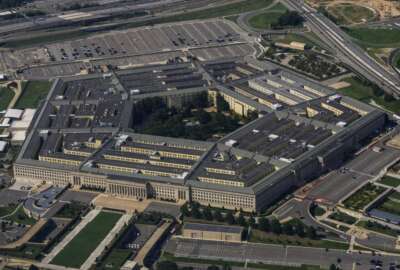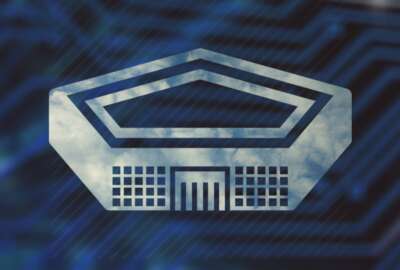Hubbard Radio Washington DC, LLC. All rights reserved. This website is not intended for users located within the European Economic Area.
On Air: Federal News Network
Trending:
DoD Cloud Exchange 2024: USTRANSCOM’s Michael Howard on becoming a more agile-minded organization
The U.S. Transportation Command will kick off a three-year effort to make it easier for users to access data anywhere, anytime, its transformation chief says.
The U.S. Transportation Command isn’t new to cloud services. The command has put workloads and applications in off-premise compute and store instances since 2016.
Despite its time and experience using cloud, USTRANSCOM continues to take a measured approach in how it expands the use of these capabilities.
Michael Howard, engineering and digital transformation division chief at USTRANSCOM, said about 60% of the command’s working capital fund programs are currently in the cloud, mostly though an infrastructure as a service approach.
Over the coming next few years, the goal is to combine process with technology to become a more agile organization, Howard said during Federal News Network’s DoD Cloud Exchange.
An important step in that direction is an upcoming update to the agency’s memo guiding IT modernization .
“The memo helps us set the tone for all of our IT efforts. It really shows the strategic level importance of modernization in an organization like USTRANSCOM that really needs to strive at being at the leading edge of the transportation industry,” Howard said. “We’re not only shifting our software development processes to be more agile, but at an organizational level, we’re also shifting to be more agile-minded. The modernization memo really projects some goals over the next 12 to 18 months.”
Improving USTRANSCOM’s IT management
USTRANSCOM also wants to further expand its DevSecOps platform and end the use of the waterfall development methodology, he said. It also wants to create a continuous authorization to operate process that is coupled with the agency’s software architecture and containerized microservices.
“We really will finally get after what we know today is as the way things communicate through ports and protocols, and really adopting application programming interface-based communication,” Howard said. “The key ingredient to it is something we added this year when the chief financial officer joined the chief information officer as a signature authority. We’re synergized from a business perspective, and we want to be cost-informed as we strategically move through this memo, certainly over the next 12 to 18 months.”
With the CFO actively involved with technology planning and implementation, Howard said command leaders can better answer questions about the cost to develop and sustain IT programs as well as the prioritization of these initiatives.
“To quote our CFO, she says, ‘One of my biggest problems is managing our IT portfolio.’ It’s the same problem, I think, across the entire DoD. The fortunate thing for USTRANSCOM is we are a working capital fund, whereas the appropriated combatant commands have to demonstrate a lot more scrutiny. We have some flexibility, but we also know that flexibility needs to have some responsibility,” he said. “Our memo before missed an opportunity where we could be more cost-informed. The other thing that does is it now provides some audit capability of that cost, schedule and performance — and then helps us be good stewards of taxpayer dollars as we maneuver through the cloud.”
New USTRANSCOM cloud initiative
A new initiative called USTRANSCOM Anywhere illustrates this more integrated approach to cloud.
The command wants to use Microsoft Azure for cloud hosting to gain some of the capabilities that come with the disconnected Microsoft Azure stack hosted on premise today. Through the Azure stack, USTRANSCOM would deploy capabilities as microservices so the right person could access data at the right time from anywhere through the unclassified network, Howard said.
“What we realized is that once we achieve a platform as a service capability of microsegmented, data-containerized applications, the next thing would be is how can that microsegmented data exist in a denied, degraded, intermittent or limited — DDIL — environment,” he said. “USTRANSCOM Anywhere has a focus to utilize our current [unclassified network] that we provide today and to segment that capability in a continuous integration, continuous delivery fashion.”
The agency will roll out USTRANSCOM Anywhere in a three-phased approach over the next three years.
Howard said this first year is focused on creating the “landing zone” to determine what services users will need most in the environment.
“That culminates with a beta test. Today, I think we looked at about 25 uses. That might increase as we learn more about the environment. It also culminates with 70 of 91 zero trust target-level activities,” he said. “Phase 2 looks like a deployment phase. We will look at the migration of on-premise services that we provide today and house them in the Azure cloud capability. Then, Phase 3 looks like the test and use cases in the disconnected state. We will look to the Azure stack capability to provide some of the microsegmented data in certain parts geographically to try to get it to as close as to what we would provide the warfighter tomorrow.”
Scalability, reliability of cloud services
Howard acknowledged this would be a major culture shift from how USTRANSCOM operates today and has for decades.
As part of the USTRANSCOM Anywhere initiative, the agency expects to introduce a virtual desktop infrastructure and a disconnected capability through the cloud.
“First and foremost, I suppose it’s an understanding of how this will work for global logistics. We wouldn’t want to rush to that,” Howard said. “Secondly, I would say that in the first year, this is really a proof of concept. We, again, with our CFO, are in line to prove out in that first year that this is really something that we want to do, instead of saying, ‘Yeah, we’re all in, and we have no points of return.’ The phasing really helps us get to some decision points to ensure that this is exactly how we want to proceed forward.”
Through all of these updated memos, new procedures and technology pilots, Howard said one of the most important goals is to improve how the command takes advantage of the scalability and reliability of cloud services to improve logistics, especially in a contested environment.
Getting warfighters the data necessary to make better and faster decisions is the most important metric underlying these efforts, he said.
“What’s nice is, today, with our modernization memo, we’re able to somewhat forecast what the probability is of cost, schedule and performance for an application to migrate, whether lift-and-shift or migrate through a DevSecOps platform. What’s nice about that is we are tied in with our enterprise IT portfolio mission area manager or our chief operating officer that’s listed on our modernization memo. And we give quarterly updates. Those quarterly updates actually go into an update to our CEO,” Howard said.
“We’re describing the benefits of a fully modernized platform as a service, where you have microsegmented containerized applications that exist for business function, have immutable code and are really, for lack of better words, defendable. The end state is truly that capability to be business-focused. It’s not that you do zero trust. It’s how you use it, and this is the same thing: It’s not that we’re doing the cloud. It’s how we’re using it.”
Discover more articles and videos now on Federal News Network’s DoD Cloud Exchange event page.
Copyright © 2024 Federal News Network. All rights reserved. This website is not intended for users located within the European Economic Area.
Jason Miller
Jason Miller is executive editor of Federal News Network and directs news coverage on the people, policy and programs of the federal government.
Follow @jmillerWFED
Related Stories
Exclusive
Defense News
Read more





